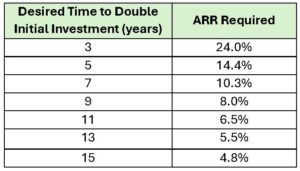
The Rule of 72 is a simple way to estimate how long it takes for an investment to double based on its annual rate of return (ARR). For example, if the ARR is 7.2% then it would take 10 years to double the initial investment (72/7.2% = 10 years).
Years to Double Investment = 72 / Annual Rate of Return
The recent stock market appreciation over the last decade (using the S&P 500 Index’s total return of 14.6%) meant that if you had allocated capital to the broad U.S. equity market back in October 2015, your initial investment was able to double in value every ~4.9 years (72/14.6%). To quantify it in dollar terms, $100,000 investment in the S&P 500 10 years ago would grow to $390,702 (a 291% cumulative return). Conversely, a $100,000 invested in the total investment-grade U.S. bond market over the same time period would amount to only $120,710 (a 21% cumulative return) and take close to 38 years to double based on its 10-year annual return of 1.9% (72/1.9% = 37.9 years).
Below is a table to show the time that is needed to double the value of an investment using various annual rates of return:

The Rule of 72 can also be used in reverse to see what rate of return is needed to double an investment’s value in a desired time frame by changing the denominator to years instead of annual percentage return. If you want to double your money in 7.2 years, then it would require an ARR of 10% (72/7.2 years = 10%).
ARR Required = 72 / Desired Time to Double Investment

The Rule of 72 is a quick and useful approximation to use as a guideline and reminder that even modest returns can create meaningful growth over time


